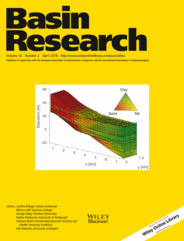
Full text loading...
Long‐term (106–7 yr) clastic sedimentary fluxes to the ocean provide first‐order constraints on the response of continental surfaces to both tectonic and climatic forcing as well as the supply that builds the stratigraphic record. Here, we use the dated and regionally correlated relict lateritic landforms preserved over Sub‐Saharan West Africa to map and quantify regional denudation as well as the export of main catchments for three time intervals (45–24, 24–11 and 11–0 Ma). At the scale of West Africa, denudation rates are low (ca. 7 m Myr−1) and total clastic export rate represents 18.5 × 103 km3 Myr−1. Export rate variations among the different drainage groups depend on the drainage area and, more importantly, rock uplift. Denuded volumes and offshore accumulations are of the same magnitude, with a noticeably balanced budget between the Niger River delta and its catchment. This supports the establishment of the modern Niger catchment before 29 Ma, which then provided sufficient clastic material to the Niger delta by mainly collecting the erosion products of the Hoggar hotspot swell. Accumulations on the remaining Equatorial Atlantic margin of Africa suggest an apparent export deficit but the sediment budget is complicated by the low resolution of the offshore data and potential lateral sediment supply from the Niger delta. Further distortion of the depositional record by intracontinental transient storage and lateral input or destabilization of sediments along the margin may be identified in several locations, prompting caution when deducing continental denudation rates from accumulation only.

Article metrics loading...

Full text loading...
References


Data & Media loading...
Supplements

